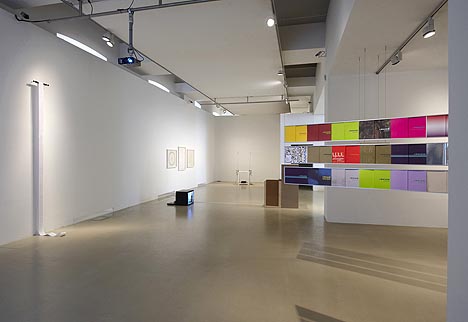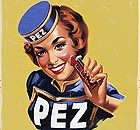
translated and summarized by: Liz Wollner-Grandville,
English summary April 19 - 25
Kunstraum Niederoesterreich
Translation is a mode
09.04.10 – 29.05.10
Translation as a motive
Fifteen artists and artists’ collectives are currently displaying their work at the Kunstraum Niederoesterreich. The works, which mainly centre on the topic ‘translation’, attempt to encapsulate the moment a design transmutes into a different form, leaving the door open for a multitude of interpretations. Birgit Rinagl and Franz Thalmair, curators of the exhibition and members of CONT3XT.NET based the presentation on Walter Benjamin’s essay “The Task of the Translator” (1921). One of their aspirations was to “translate” art from virtual space into exhibition space.
In their witty work “TextEdit”, the American artists Alyor Braun and Arend de Gruyter-Helfer present five pieces of various tones of black and gray woven cloth, which, by using Apple’s TextEdit software, render a dialogue between the artists. Their statements are woven on a digitalized loom - transforming text into a woven fabric.
The Austrian artist Gerhard Dirnmoser deals with translations in an analytic rather than a synthetic manner. Following his extensive research on the term “exhibition” he created a huge diagram, presenting ramifications and catchwords such as “exhibition from a materialistic point of view” or “exhibition as a narration”.
Categories of recurring everyday activities during the course of a year, (in this case, the year 2005), which include activities such as “sleeping, eating, producing art, and communicating ” are typed onto an infinite loop by the Austrian sculptor Arnold Reinthaler. To symbolize the hours, a line is assigned to each category - one line equalling one hour. Reinthaler relates his work to art created in the 1960’s or to Roman Opalka’s photographs – both attempt to freeze time with the help of art.
The poetic work by the Serbian artist Aleksandra Domanovic, who lives in Berlin, has nothing to do with translation. In Domanovic’s work “Hottest to Coldest, com” (2008) names of cities such as Maputo, Vienna, Bamako and many others show up on a terminal - in a constantly, seemingly random order; but the city names appear in sequence from the warmest to the coldest location. Measurements obtained from 200 meteorological stations around the globe are continuously posted on Domanovic’s website www.hottestotcoldest.com.
While the exhibition is, for the most part, worthwhile seeing, the theoretical framework of reflecting artistically on the essence of translations is not always coherent, and sometimes even redundant. The works speak for themselves.
By Susanne Rohringer
Kunstraum Niederoesterreich
1010 Vienna, Herrengasse 13
www.kunstraum.net
Opening hours: Tue – Fri 11 a.m. – 7 p.m., Thu 11 a.m. – 8 p.m. , Sat 11 a.m. – 3 p.m.
Galerie Krobath
Gerold Miller
24.03.10 – 30.04.10
A frame, please!?
What comes to one’s mind if one views art in isolation from any art historical and theoretical context? Can one consume art in a “conscious associative practice”; respectively is a description, a literary, psychologically anchored stream of consciousness, as coined by Samuel Beckett or Jack Kerouac, applicable for art objects without estranging the intended meaning?
In case individual associations are permitted, a clearly connoted outcome for Gerold Miller’s works cannot be guaranteed - clear in the sense of a content-related contrast between artworks and utility and design objects. What immediately comes to one’s mind are formal analogies to the 1970’s, high-tech IKEA-design or avant-garde design for hatchways, toilet seats? or iPad covers.
But to what or to whom do the works refer? An exhibit shown at the London-based Rocket Gallery was titled “What do you represent?” An insinuation to a cartoon by Ad Reinhardt, which shows a viewer pointing to a painting and commenting: Ha, ha, what does this represent? The picture’s answer being: What do you represent?
A similar line of argument is also apparent in Miller’s works. The minimalistic aluminium and copper wall applications glazed with car paint leaving an empty space in the middle. They refer to the frame-problem in modernistic tradition, something Malevich, Robert Ryman, or Joe Baer already dealt with. Not the painting, but the emancipated frame and the liberated wall come into play. If figurative painting focuses on external painting and abstract painting focuses on internal procedures, this form concentrates on constructing a spatial system of reference. The works, arranged in different work groups, are called “total objects”. The emptiness of the picture is what transforms the viewer, not the picture, into a reference system. As the artist describes it: Ultimately these works are cogitation objects, imaginations that took shape, layouts of a mental picture, fostered by the aesthetics of fashion, design, art and the arbitrary effect of any visual media.
Even if this form of minimal art did not propel my chain of associations into wild imaginary elevations, I can stick to my “conscious associative practice” and ask: what do you represent?
By Paul Gründorfer
Galerie Krobath
1010 Vienna, Eschenbachgasse 9
www.galeriekrobath.at
Opening hours: Tue – Fri 11 a.m. – 6 p.m., Sat 11 a.m. – 3 p.m.
WAGNER:WERK Museum Postsparkasse der BAWAG P.S.K.
Feminine Fifties – The Wirtschaftswunder Women
13.04.10 – 22.05.10
Teenager on the shelf
Teenagers as ceramic figures - sitting on scooters, or wearing perky scarves, drainpipes, duffle coats, and other absolutely essential 1950-accessories; or, as an alternative, ceramic figures of Javanese women or women belonging to other ethnic groups.
On the occasion of the 90th anniversary of the Viennese ceramics manufacturer Keramos, the WAGNER:WERK Museum Postsparkasse takes a closer look at women and everyday life of the 1950’s. In those days, the ideal woman was seen as a fashionably dressed house- and family manager, happily swaying a cooking spoon in her pastel-coloured kitchen, and, thanks to modern household appliances, able to spend the evening reading a book in a cocktail-chair.
The coffee sets, vases, wall masks, and bric-a-brac manufactured by Keramos are the prototypical accessories of the 50’s. The renowned Wiener Werkstätte influenced many of the designers working for Keramos, and, formally, the designs were on the same level as those by Bimini, Hagenauer and Goldscheider - but at some point drifted beyond the nebulous border of Kitsch.
All of this only has a peripheral effect on the predominantly architecture- and design oriented exhibition. But the Keramos figures offer a great opportunity to illustrate the image of everyday life during the 1950’s in an ambitious and entertaining way.
By Iris Meder
WAGNER:WERK Museum Postsparkasse der BAWAG P.S.K.
1018 Vienna, Georg-Coch-Platz 2
www.ottowagner.com
Opening hours: Mon – Wed 8 a.m. – 3 p.m. , Thu 8 a.m. – 5.30 p.m., Sat 10 a.m. – 5 p.m.
Galerie mezzanin
Michelangelo Pistoletto – Mirror Paintings
24.03.10 – 30.04.10
In the mirror of contemporary history
Michelangelo Pistoletto is one of those artists who does not muscle his way into the art business, but always find a way to leave his traces. It’s all a question of dosage. At the last Venice Bienniale he attracted attention with just one blow of the hammer: his installation “Twenty-two less two” consisted of 22 gold-framed mirrors, of which he destroyed all but two.
Mirrors are also the central theme of his first solo exhibit at the Vienna-based Galerie mezzanin, (this also being his first show in Vienna since 1995, when he presented his works at the 20er Haus). Five mirrors, all following the same principle: a free standing object, usually a figure, is mounted as a serigraphy onto polished stainless steel. The reflection of the viewer becomes an essential part of the painting.
Pistoletto transforms the installation into a stage and the viewer’s encounter with the artwork immediately triggers a performance. With a height of nearly two and a half meters the works have the size of a door; and the one mounted immediately vis-à-vis the entrance is the only one in a horizontal format and conveys the feeling of a window, opening the exhibition to an imaginary outside room. At the same time, the doors and the window of the White Cube let reality, which is outside of the cube, permeate – be it a political, social, or cultural reality. But what is actually happening is secondary: at the exhibition currently presented in Vienna, the individual images centre on rebellion, revolution and their suppression. They show a symbolic skull, a peace-flag, and a man just about to hurl a stone into an invisible group of people. A scene depicting a young woman supporting a collapsing man is the Grand Finale. With this picture narration, Pistoletto delivers a clear political commentary. By working with different kinds of realities - all kept apart by cold steel - he refers to the individual’s helplessness when faced with the arbitrary exertion of power, similar to what is currently happening in his country.
By Johanna Hofleitner
Galerie mezzanin
1010 Vienna, Getreidemarkt 14/Ecke Eschenbachgasse
www.mezzaningallery.com
Opening hours: Tue – Fri: noon – 6 p.m., Sat: 11 a.m. – 2 p.m.
Mehr Texte von translated and summarized by: Liz Wollner-Grandville


 Teilen
Teilen





